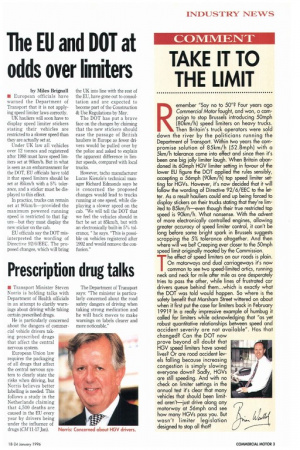TAKE IT TO THE LIMIT
Page 5

If you've noticed an error in this article please click here to report it so we can fix it.
Remember "Say no to 50"? Four years ago Commercial Motor fought, and won, a campaign to stop Brussels introducing 50mph (80km/h) speed limiters on heavy trucks. Then Britain's truck operators were sold down the river by the politicians running the Department of Transport. Within two years the compromise solution of 85km/h (52.8mph) with a 5km/h tolerance came into effect and since then it's been one big jolly limiter laugh. When Britain abandoned its 60mph HGV limiter setting in favour of the lower EU figure the DOT applied the rules sensibly, accepting a 56mph (90km/h) top speed limiter setting for HGVs. However, it's now decided that it will follow the wording of Directive 92/6/EEC to the letter. As a result hauliers could end up being forced to display stickers on their trucks stating that they're limited to 85km/h—even though their true restricted top speed is 90km/h. What nonsense. With the advent of more electronically controlled engines, allowing greater accuracy of speed limiter control, it can't be Fong before some bright spark in Brussels suggests scrapping the 5% tolerance altogether. And then where will we be? Creeping ever closer to the 50mpli speed limit originally mooted by the Commission. The effect of speed limiters on our roads is plain. On motorways and dual carriageways it's now common to see two speed-limited artics, running neck and neck for mile after mile as one desperately tries to pass the other, while lines of frustrated car drivers queue behind them.. .which is exactly what the DOT was told would happen. So where is the safety benefit that Marsham Street wittered on about when it first put the case for limiters back in February 1991? In a really impressive example of humbug it called for limiters while acknowledging that "as yet robust quantitative relationships between speed and accident severity are not available". Has that changed? Can the DOT now prove beyond all doubt that HGV speed limiters have saved lives? Or are road accident levels falling because increasing congestion is simply slowing everyone down? Sadly, HGVs are still speeding. And with no check on limiter settings in the annual test it's clear that many vehicles that should been limit ed aren't—just drive along any motorway at 56mph and see how many HGVs pass you. But wasn't limiter legislation designed to stop all that?
































































































